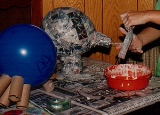
Papier-mâché
Encyclopedia

Composite material
Composite materials, often shortened to composites or called composition materials, are engineered or naturally occurring materials made from two or more constituent materials with significantly different physical or chemical properties which remain separate and distinct at the macroscopic or...
consisting of paper
Paper
Paper is a thin material mainly used for writing upon, printing upon, drawing or for packaging. It is produced by pressing together moist fibers, typically cellulose pulp derived from wood, rags or grasses, and drying them into flexible sheets....
pieces or pulp, sometimes reinforced with textile
Textile
A textile or cloth is a flexible woven material consisting of a network of natural or artificial fibres often referred to as thread or yarn. Yarn is produced by spinning raw fibres of wool, flax, cotton, or other material to produce long strands...
s, bound with an adhesive, such as glue
Glue
This is a list of various types of glue. Historically, the term "glue" only referred to protein colloids prepared from animal flesh. The meaning has been extended to refer to any fluid adhesive....
, starch
Starch
Starch or amylum is a carbohydrate consisting of a large number of glucose units joined together by glycosidic bonds. This polysaccharide is produced by all green plants as an energy store...
, or wallpaper paste.
Composition
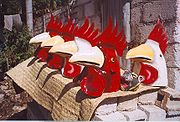
Cream
Cream is a dairy product that is composed of the higher-butterfat layer skimmed from the top of milk before homogenization. In un-homogenized milk, over time, the lighter fat rises to the top. In the industrial production of cream this process is accelerated by using centrifuges called "separators"...
. While any adhesive can be used if thinned to a similar texture, such as polyvinyl acetate
Polyvinyl acetate
Polyvinyl acetate, PVA, PVAc, poly, is a rubbery synthetic polymer with the formula n. It belongs to the polyvinyl esters family with the general formula -[RCOOCHCH2]-...
based glues (wood glue or, in the US, white Elmer's
Elmer's Products, Inc.
Elmer's Products, Inc. is the manufacturer of Elmer's Glue-All and other crafts and home repair products, including Krazy Glue, Ross Glue, ProBond adhesives, and X-Acto craft knives. Elmer's also produces foamboard and presentation board. It has its headquarters in Columbus, Ohio.The brand was...
glue), the flour and water mixture is the most economical. Adding oil of cloves
Oil of cloves
Oil of cloves, also known as clove oil, is an essential oil from the clove plant, Syzygium aromaticum.* CAS number: 8000-34-8It is a natural analgaesic and antiseptic used primarily in dentistry for its main ingredient eugenol...
or other additives to the mixture reduces the chances of the product developing mold
Mold
Molds are fungi that grow in the form of multicellular filaments called hyphae. Molds are not considered to be microbes but microscopic fungi that grow as single cells called yeasts...
. The paper is cut or torn into strips, and soaked in the paste until saturated. The saturated pieces are then placed onto the surface and allowed to dry slowly; drying in an oven can cause warping or other dimensional changes during the drying process. The strips may be placed on an armature, or skeleton, often of wire mesh over a structural frame, or they can be placed on an object to create a cast. Oil or grease can be used as a release agent if needed. Once dried, the resulting material can be cut, sanded and/or painted, and waterproofed by painting with a suitable water repelling paint.
Ancient Egypt
In ancient Egypt, coffins and death maskDeath mask
In Western cultures a death mask is a wax or plaster cast made of a person’s face following death. Death masks may be mementos of the dead, or be used for creation of portraits...
s were often made from cartonnage
Cartonnage
Cartonnage is a type of material composing Egyptian funerary masks from the First Intermediate Period onward. It was made of layers of linen or papyrus covered with plaster. Some of the Fayum mummy portraits are also painted on panels made of cartonnage....
- layers of papyrus
Papyrus
Papyrus is a thick paper-like material produced from the pith of the papyrus plant, Cyperus papyrus, a wetland sedge that was once abundant in the Nile Delta of Egypt....
or linen
Linen
Linen is a textile made from the fibers of the flax plant, Linum usitatissimum. Linen is labor-intensive to manufacture, but when it is made into garments, it is valued for its exceptional coolness and freshness in hot weather....
covered with plaster
Plaster
Plaster is a building material used for coating walls and ceilings. Plaster starts as a dry powder similar to mortar or cement and like those materials it is mixed with water to form a paste which liberates heat and then hardens. Unlike mortar and cement, plaster remains quite soft after setting,...
.
Middle and Far East
In Persia and Kashmir, papier-mâché has been used to manufacture small painted boxes, trays, and cases. Japan and China also produce laminated paper articles using papier-mâché. In Japan and India, papier-mâché was used to add decorative elements to armor and shields.Europe

Plaster
Plaster is a building material used for coating walls and ceilings. Plaster starts as a dry powder similar to mortar or cement and like those materials it is mixed with water to form a paste which liberates heat and then hardens. Unlike mortar and cement, plaster remains quite soft after setting,...
or carved wood in architecture. Henry Clay of Birmingham
Birmingham
Birmingham is a city and metropolitan borough in the West Midlands of England. It is the most populous British city outside the capital London, with a population of 1,036,900 , and lies at the heart of the West Midlands conurbation, the second most populous urban area in the United Kingdom with a...
, England
England
England is a country that is part of the United Kingdom. It shares land borders with Scotland to the north and Wales to the west; the Irish Sea is to the north west, the Celtic Sea to the south west, with the North Sea to the east and the English Channel to the south separating it from continental...
, patented a process for treating laminated sheets of paper with linseed oil
Linseed oil
Linseed oil, also known as flaxseed oil, is a clear to yellowish oil obtained from the dried ripe seeds of the flax plant . The oil is obtained by cold pressing, sometimes followed by solvent extraction...
to produce waterproof panels in 1772. These sheets were used for building coach door panels, amongst other structural uses. Theodore Jennens patented a process in 1847 for steaming and pressing these laminated sheets into various shapes, which was then used to manufacture trays, chair backs, and structural panels, usually laid over a wood or metal armature for strength. The papier-mâché was smoothed and lacquer
Lacquer
In a general sense, lacquer is a somewhat imprecise term for a clear or coloured varnish that dries by solvent evaporation and often a curing process as well that produces a hard, durable finish, in any sheen level from ultra matte to high gloss and that can be further polished as required...
ed, or finished with a pearl shell finish. The industry lasted through the 19th century. Russia had a thriving industry in ornamental papier-mâché. A large assortment of painted Russian papier-mâché items appear in a Tiffany & Co.
Tiffany & Co.
Tiffany & Co. is an American jewelry and silverware company. As part of its branding, the company is strongly associated with its Tiffany Blue , which is a registered trademark.- History :...
catalog from 1893.
Martin Travers
Martin Travers
Martin Travers was an English church artist and designer, whose name is often connected with the Anglo-Catholic movement in the Church of England, especially that part of the movement which favoured a return to the Baroque style of church furnishing...
the English ecclesiastical designer made much use of papier mache for his church furnishings in the 1930s.
Papier-mâché has been used for doll heads starting as early as 1540, molded in two parts from a mixture of paper pulp, clay, and plaster, and then glued together, with the head then smoothed, painted and varnished.
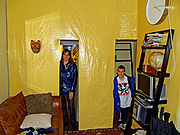
Paper boats
One common item made in the 19th century in America was the paper canoeCanoe
A canoe or Canadian canoe is a small narrow boat, typically human-powered, though it may also be powered by sails or small electric or gas motors. Canoes are usually pointed at both bow and stern and are normally open on top, but can be decked over A canoe (North American English) or Canadian...
, most famously made by Waters & Sons of Troy
Troy, New York
Troy is a city in the US State of New York and the seat of Rensselaer County. Troy is located on the western edge of Rensselaer County and on the eastern bank of the Hudson River. Troy has close ties to the nearby cities of Albany and Schenectady, forming a region popularly called the Capital...
, New York. The invention of the continuous sheet paper machine allows paper sheets to be made of any length, and this made an ideal material for building a seamless boat hull
Hull (watercraft)
A hull is the watertight body of a ship or boat. Above the hull is the superstructure and/or deckhouse, where present. The line where the hull meets the water surface is called the waterline.The structure of the hull varies depending on the vessel type...
. The paper of the time was significantly stretchier than modern paper, especially when damp, and this was used to good effect in the manufacture of paper boats. A layer of thick, dampened paper was placed over a hull mold and tacked down at the edges. A layer of glue was added, allowed to dry, and sanded down. Additional layers of paper and glue could be added to achieve the desired thickness, and cloth could be added as well to provide additional strength and stiffness. The final product was trimmed, reinforced with wooden strips at the keel
Keel
In boats and ships, keel can refer to either of two parts: a structural element, or a hydrodynamic element. These parts overlap. As the laying down of the keel is the initial step in construction of a ship, in British and American shipbuilding traditions the construction is dated from this event...
and gunwale
Gunwale
The gunwale is a nautical term describing the top edge of the side of a boat.Wale is the same word as the skin injury, a wheal, which, too, forms a ridge. Originally the gunwale was the "Gun ridge" on a sailing warship. This represented the strengthening wale or structural band added to the design...
s to provide stiffness, and waterproofed. Paper racing shell
Racing shell
In watercraft, a racing shell is an extremely narrow, and often disproportionately long, rowing boat specifically designed for racing or exercise. It is outfitted with long oars, outriggers to hold the oarlocks away from the boat, and sliding seats...
s were highly competitive during the late 19th century. Few examples of paper boats survived. One of the best known paper boats was the canoe, the "Maria Theresa," used by Nathaniel Holmes Bishop to travel from New York to Florida in 1874–1875. An account of his travels was published in the book "Voyage of the Paper Canoe."
Paper masks
Creating Papier-mâché masks is common among elementary school children and craft lovers. Either one's own face or a balloon can be used as a mold. This is common during Halloween time as a facial mask complements the costume.Paper observatory domes
Papier-mâché panels were used in the late 19th century and early 20th century to produce lightweight domes, used primarily for observatoriesObservatory
An observatory is a location used for observing terrestrial or celestial events. Astronomy, climatology/meteorology, geology, oceanography and volcanology are examples of disciplines for which observatories have been constructed...
. The domes were constructed over a wooden or iron framework, and the first domes were made by the same manufacturer that made the early paper boats, Waters & Sons. The domes used in observatories had to be light in weight so that they could easily be rotated to position the telescope opening in any direction, and large enough so that it could cover the large refractor telescopes in use at the time.
Paper sabots
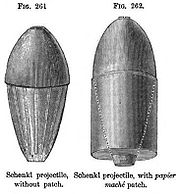
Sabot
A sabot is a device used in a firearm or cannon to fire a projectile, such as a bullet, that is smaller than the bore diameter, or which must be held in a precise position. The term is also applied to a battery stub case, a device used similarly to make a small electrical battery usable in a...
s. Despite the extremely high pressures and temperatures in the bore of a firearm, papier-mâché proved strong enough to contain the pressure, and push a sub-caliber
Caliber
In guns including firearms, caliber or calibre is the approximate internal diameter of the barrel in relation to the diameter of the projectile used in it....
projectile out of the barrel with a high degree of accuracy. Papier-mâché sabots were used in everything from small arms, such as the Dreyse needle gun
Needle gun
The Dreyse needle-gun was a military breechloading rifle, famous as the main infantry weapon of the Prussians, who adopted it for service in 1848 as the Dreyse Zündnadelgewehr, or Prussian Model 1848...
, up to artillery
Artillery
Originally applied to any group of infantry primarily armed with projectile weapons, artillery has over time become limited in meaning to refer only to those engines of war that operate by projection of munitions far beyond the range of effect of personal weapons...
, such as the Schenkl projectile.
Modern use
With modern plastics and composites taking over the decorative and structural roles that papier-mâché played in the past, papier-mâché has become less of a commercial product. There are exceptions, such as MicartaMicarta
Micarta is a trademark of Norplex-Micarta industrial high pressure laminates and refers to a composite of linen, canvas, paper, fiberglass, carbon fiber or other fabric in a thermosetting plastic, originally used in electrical and decorative Koekjes applications. Micarta was developed by George...
, a modern paper composite, and traditional applications such as the piñata
Piñata
A piñata is a papier-mâché or other type of container that is decorated, filled with toys and or candy and then broken as part of a ceremony or celebration. Piñatas are most commonly associated with Mexico, but its origins are considered to be in China...
. It is still used in cases where the ease of construction and low cost are important, such as in arts and crafts
Arts and crafts
Arts and crafts comprise a whole host of activities and hobbies that are related to making things with one's hands and skill. These can be sub-divided into handicrafts or "traditional crafts" and "the rest"...
.
Carnival floats
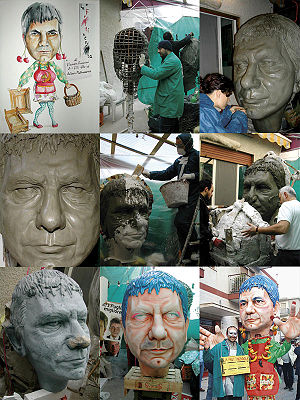
Carnival
Carnaval is a festive season which occurs immediately before Lent; the main events are usually during February. Carnaval typically involves a public celebration or parade combining some elements of a circus, mask and public street party...
floats
Float (parade)
A float is a decorated platform, either built on a vehicle or towed behind one, which is a component of many festive parades, such as those of Mardi Gras in New Orleans, the Carnival of Viareggio, the Maltese Carnival, the Macy's Thanksgiving Day Parade, the Key West Fantasy Fest parade, the...
. A basic structure of wood, metal and metal wire is covered in papier-mâché. Once dried, details are added. The papier-mâché is then sanded and painted. Carnival floats can be very large and comprise a number of characters, props and scenic elements all organized around a chosen theme. They can also accommodate several dozens people, including the operators of the mechanisms. The floats can have movable parts, like the facial features of a character or its limbs. It is not unusual for local professional architects, engineers, painters, sculptors and ceramists to take part in the design and construction of the floats. New Orleans Mardi Gras
New Orleans Mardi Gras
Mardi Gras in New Orleans, Louisiana, is a Carnival celebration well-known throughout the world.The New Orleans Carnival season, with roots in preparing for the start of the Christian season of Lent, starts after Twelfth Night, on Epiphany . It is a season of parades, balls , and king cake parties...
float maker Blaine Kern, operator of the Mardi Gras World float museum, brings Carnival float artists from Italy to work on his floats.
Theatrical use
Papier-mâché, while losing ground to modern plasticPlastic
A plastic material is any of a wide range of synthetic or semi-synthetic organic solids used in the manufacture of industrial products. Plastics are typically polymers of high molecular mass, and may contain other substances to improve performance and/or reduce production costs...
s, has been and remains a good medium for theatrical use, both for sets and costume elements, especially when budgetary constraint prohibit more expensive alternatives. Cardboard or wire mesh can be used to create the armature.
Military drop tanks
During WWII, military aircraft fuel tanks were constructed out of plastic impregnated paper, and used to extend the range of aircraft. These tanks were plumbed to the regular fuel system via detachable fittings and dropped from the aircraft when the fuel was expended, allowing short-range aircraft such as fighters to accompany long-range aircraft such as bombers on longer missions as protection forces. Two types of paper tanks were used, a 200 gallon (758 l) conformal fuel tankConformal fuel tank
Conformal fuel tanks are additional fuel tanks fitted closely to the profile of an aircraft which extend either the range or "time on station" of the aircraft, with a reduced aerodynamic penalty compared to external drop tanks....
made by the US for the P-47 Thunderbolt
P-47 Thunderbolt
Republic Aviation's P-47 Thunderbolt, also known as the "Jug", was the largest, heaviest, and most expensive fighter aircraft in history to be powered by a single reciprocating engine. It was heavily armed with eight .50-caliber machine guns, four per wing. When fully loaded, the P-47 weighed up to...
, and a 108 gallon (409 l) cylindrical drop tank
Drop tank
In aeronautics, a drop tank is used to describe auxiliary fuel tanks externally carried by aircraft. A drop tank is expendable and often jettisonable...
made by the British and used by the P-47 and the P-51 Mustang
P-51 Mustang
The North American Aviation P-51 Mustang was an American long-range, single-seat fighter and fighter-bomber used during World War II, the Korean War and in several other conflicts...
.
See also
- Russian lacquer artRussian lacquer artRussian lacquer art developed from the art of icon painting which came to an end with the collapse of Imperial Russia. The icon painters, who previously had been employed by supplying not only churches but people's homes, needed a way to make a living...
- DecoupageDecoupageDecoupage is the art of decorating an object by gluing colored paper cutouts onto it in combination with special paint effects, gold leaf and so on. Commonly an object like a small box or an item of furniture is covered by cutouts from magazines or from purpose-manufactured papers...
- JapanningJapanningJapanning describes the European imitation of Asian lacquerwork, originally used on furniture. The word originated in the 17th century.- Japanned :Japanned is most often a heavy black lacquer, almost like enamel paint...
- Hanji (Korean paper art)Hanji (Korean paper art)Korean paper or hanji is the name of traditional handmade paper from Korea. Hanji is made from the inner bark of Paper Mulberry, a tree native to Korea that grows well on its rocky mountainsides, known in Korean as dak. The formation aid crucial to making hanji is the mucilage that oozes from the...
- Papier mache bindingPapier mache bindingPapier Mache binding was a form of binding a book used in the mid-nineteenth century. The boards were formed from a paper paste and molded into various shapes and designs....
, a form of binding a book used in the 19th century - Papier-mâché TiaraPapier-mâché TiaraThe papier-mâché tiara is a papal tiara that was made in exile for Pope Pius VII's papal coronation in a church in Venice. In 1798, Pope Pius's predecessor Pope Pius VI had been forced into exile when French troops invaded the Vatican and stole or destroyed all the ancient papal tiaras owned by the...
, a papal tiara made in exile for Pope Pius VII's papal coronation in a church in Venice in 1800 - Wet-foldingWet-foldingWet-folding is an origami technique developed by Akira Yoshizawa that employs water to dampen the paper so that it can be manipulated more easily. This process adds an element of sculpture to origami, which is otherwise purely geometric. Wet-folding is used very often by professional folders for...
, an OrigamiOrigamiis the traditional Japanese art of paper folding, which started in the 17th century AD at the latest and was popularized outside Japan in the mid-1900s. It has since then evolved into a modern art form...
technique that uses damp paper.

